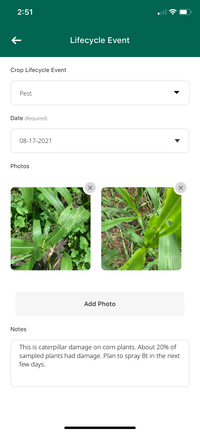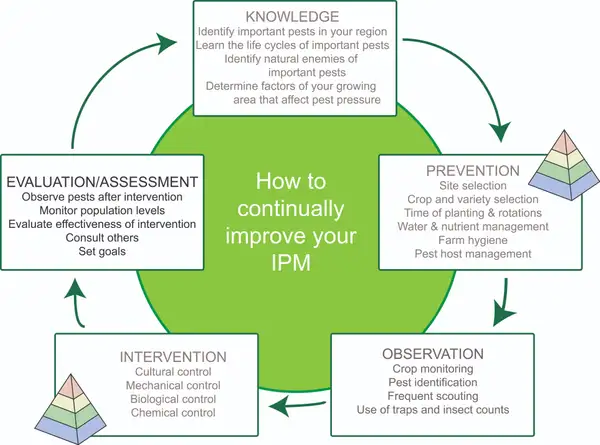This article is the fourth and final segment of ECHO's Integrated Pest Management (IPM) series focusing on insect pests. The first three articles about pest prevention [http://edn.link/prevent], monitoring [http://edn.link/ipm2], and control [http://edn.link/ipm3] are available on ECHOcommunity.org. This article will focus on evaluating pest management strategies and assessing which ones to include and prioritize for future implementation.
Monitor pest populations after strategy implementation
After attempting to prevent or control a pest, farmers should monitor pest activity to accurately evaluate the effectiveness of their interventions and overall management approach. Monitoring pests and evaluating the effectiveness of a preventative strategy may require time and patience as many preventive strategies take weeks, months, or even years of implementation. Monitor preventative strategies intensively at the beginning of a cropping season to determine if the strategy keeps pest populations from building up or entering the field. To evaluate the efficacy of a suppressive strategy meant to control existing pests, monitor pest populations in the short-term—within a few days of the intervention to ensure crop protection. If utilizing a chemical intervention to control a pest, begin monitoring pests only after it is safe to reenter application areas. Restricted entry intervals (REIs)4 should be listed on product labels or found by researching the pesticide's active ingredient or common name. Table 2 lists some examples of different control strategies and some estimated timelines for monitoring.
| Strategy | Type of control | Category of control | Monitor timeline |
|---|---|---|---|
| Trenches (e.g. beetle control) | preventative | cultural | Monitor within the first season, especially the beginning of the pests’ life cycle in the region. |
| Attracting beneficial insects | preventative | biological | Monitor over several years, including during the off-season when crops are not growing. |
| Systemic* pesticide spray | suppressive | chemical | Monitor in the following 3-10 days after spraying. Systemic pesticides can take several days to travel to all parts of the plant after uptake to be effective. |
| Soap and oil spray | suppressive | mechanical/physical | Monitor after the soap and oil dry (within 2 days). Soap and oil act on the exterior of the pest- suffocating it or breaking down outer tissues. The spray is only effective as long as it stays wet and makes contact with the pests. |
| * Systemic pesticides are those that a plant absorbs then distributes throughout plant tissues to reach all plant parts. | |||
Monitoring pest levels can be done with the same techniques as overviewed in the second article [http://edn.link/ipm2#sampling] (e.g., various traps, nets, etc.). Pest activity may differ depending on what interventions are used. Some interventions are toxic, causing the death of a pest at one or more life stages. Others are deterrents, which cause pests to leave the crop. Still others cause changes in pest behavior, such as the inability to molt or feed, and take more time to have a lethal effect than toxic interventions. Therefore, it is helpful to know how a strategy affects a pest when monitoring.

Figure 4. A screenshot of the ECHOcommunity app after entering pest management observations into the life cycle event feature. Source: ECHOcommunity app
When monitoring, record observations about how well pest management interventions are working, and what factors might be influencing their effectiveness.
- Which life stage(s) of targeted pests are being impacted?
- How lethal/deterring is the intervention for each life stage?
- How long does it take to affect the pest?
- Is anything unique about the weather or environment that may impact the effectiveness of a strategy?
These notes are helpful when assessing which interventions to include or exclude from an IPM plan. The ECHOcommunity app (Figure 4) allows the user to track and record information under the "My Plant Records" feature. Select 'Add a Lifecycle Event' -> 'Pest' and record information in the notes section. Useful notes to record are the management strategy, monitoring notes (both before and after implementing the strategy), and other observations. The feature also allows photos to be added to the entry.
Monitoring is essential not only for evaluating the effectiveness of an intervention but also for the continued protection of a crop. If a strategy does not control a pest population, repeat or use another strategy.
Evaluate strategies
Many factors impact how effectively a pest management strategy works. Rain shortly after a foliar application may limit how much of a product remains on the plant to control the pest. Air temperature and sunlight intensity can impact how quickly a pesticide (natural or synthetic) breaks down and, therefore, how long a pest is exposed to it. Pest exposure to a pesticide is also influenced by how evenly it is sprayed, with what size of droplets, and what surface (e.g., undersides, top of the leaves, or entire canopy) of the leaf was sprayed.
A farmer's considerations are vital to a successful and meaningful IPM plan. A sustainable, long-term investment in pest mitigation is only as good as it is acceptable to a farmer or farming community. Therefore, it must be the farmer's assessment that determines the value of a strategy. Acceptable damage to a crop is dependent on a number of factors, many of which are unique to a specific farmer's context. Factors farmers should consider in evaluating the merit of a strategy are overviewed in table 3.
| Factor | Explanation |
|---|---|
| Intended use of crop | Pest damage on a fodder crop such as napier grass (Pennisetum purpureum) is generally more acceptable than pest damage on an ornamental crop such as hibiscus (Hibiscus spp.). |
| Maturity of the crop | Plants are more susceptible to damage when young, so interventions are often more beneficial when applied earlier rather than later in a crop's life cycle. |
| Resource availability | If a farmer must travel a far distance or cannot find the materials needed for a strategy, it will lessen the value of the strategy. |
| Resource accessibility | If a farmer cannot travel to get materials due to infrastructure limitations or weather conditions, or cannot afford materials, it will lessen the value of the strategy. |
| Information availability | If a farmer cannot find information about a pesticide or strategy, it will lessen the value of the strategy. |
| Information accessibility | If a farmer is illiterate and the information available is all written or if strategy instructions are not in their native language, it will lessen the value of the strategy. |
| Cost of strategy | The ratio of cost to effectiveness of a strategy must be economically favorable for the farmer. |
| Time constraints | If a farmer does not have time to spray a pesticide multiple times, a strategy that requires repetition would be less valuable. |
| Labor constraints | If a farmer does not have enough energy or laborers to implement a strategy (trenches), it will lessen the value of the strategy. |
| Toxicity | If a strategy is highly toxic (high lethal rate) to the pest, a farmer may value it more. If a strategy is highly toxic to non-target species, such as bees, a farmer may value it less. |
| Environmental impact(s) | If a strategy negatively impacts the environment, a farmer may value it less. |
| Societal opinions | If the community does not accept, value, or feel safe with a strategy, a farmer may value it less. |
| Traditional practices | If a strategy goes against traditional practices, it may be difficult for a farmer to switch and go against cultural norms. |
Development workers, extension agents, and other practitioners can help guide farmers by asking questions about their satisfaction with a strategy they used or simply monitoring the crop alongside the farmer and asking them to share about the successes and challenges of the cropping season.
Make Goal-Oriented Adjustments to IPM Plan
Setting goals can come at any point in the IPM decision-making process, but a good time to reevaluate them is after intervening to control a pest population. As much as possible, consider sustainability as the overarching goal for pest management plans. A plan's economic, social, and environmental sustainability are all important for the continued long-term control of agricultural pests. Having and readdressing a set of goals can solidify a pest management plan around core ideas that are important to a farmer or farming community.
An example set of goals is:
- Mitigation of crop loss (no less than a minimum number of kg/acre)
- Long-term reduction of pest presence and pressure
- Low impacts on the environment
- Acceptability by the surrounding community

Figure 5. Stages of an example IPM cycle. Planning can start at any stage of the cycle, and the order of stages is flexible. The pyramid icon indicates strategies that prevent or suppress insect pests. Source: Adapted from farmbiosecurity, Creative Commons Attribution 3.0 license
Now it is time to close the loop of IPM by assessing which strategies to use for future seasons, including modifications learned or adopted as well as lessons learned from previous seasons. As discussed in earlier articles, IPM is a continual process (Figure 5) that should improve over time as you gain experience, observe pests, implement strategies to control pest populations, and evaluate the decisions you have made.
By learning, observing, and acting, you can evaluate outcomes and determine if pest management decisions are in line with your goals. This process is strategy assessment.
One approach to assessment is to list strategies under each goal that they address in order of effectiveness. More frequently listed and higher-ranked strategies should be kept/added to a pest management plan. Delete strategies that you will no longer implement, noting why they will be discontinued. For example:
- Rotate through different modes of action for stink bug chemical sprays.
- Establish white-flowering plants with nectaries for beneficial predators of stink bugs.
- Communicate with neighboring farmers about the timing of interventions to control stink bugs so that we are more synchronous in our control efforts.
Companion plant sunflowers to attract stink bugs away from main crop:too labor-intensive and didn't seem to make that big of a difference for how much labor it required. May not have timed the planting correctly to effectively trap stink bugs.
Concluding thoughts
Farmers can take other approaches to assess the value of keeping versus removing a strategy from an IPM plan, including implementing and measuring the impact of each strategy in isolated areas of a field. Farmers know and understand their fields and crops best because they are present in their fields the most and know the seasonal history of regional crop production. Farmer’s inherent creativity to solve pest problems has the potential to bring IPM strategies forward and should be encouraged. Look for opportunities to glean insights from farmers on how to effectively control pests and enhance the overall balance of agroecosystems.
Cite this article as:
Swartz, S. 2021. Insect Pest Management: Evaluation and Assessment. ECHO Development Notes no. 153.